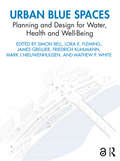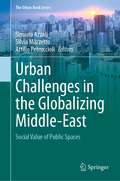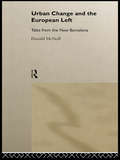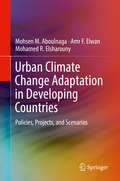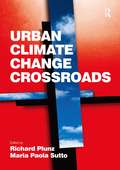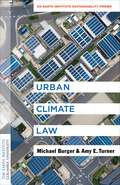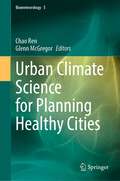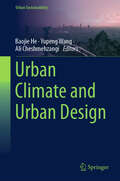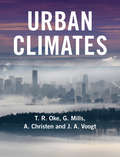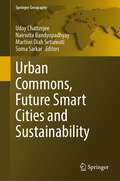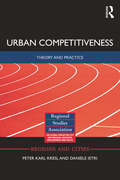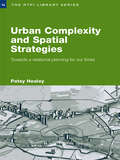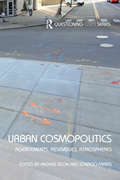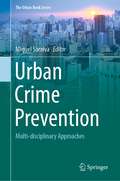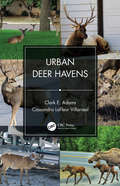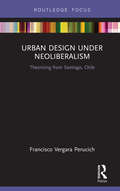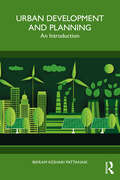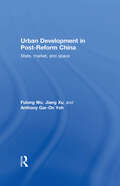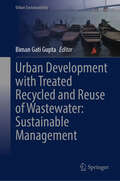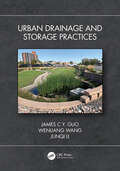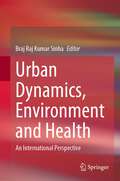- Table View
- List View
Urban Biodiversity: From Research to Practice (Routledge Studies in Urban Ecology)
by Alessandro Ossola Jari NiemeläUrban biodiversity is an increasingly popular topic among researchers. Worldwide, thousands of research projects are unravelling how urbanisation impacts the biodiversity of cities and towns, as well as its benefits for people and the environment through ecosystem services. Exciting scientific discoveries are made on a daily basis. However, researchers often lack time and opportunity to communicate these findings to the community and those in charge of managing, planning and designing for urban biodiversity. On the other hand, urban practitioners frequently ask researchers for more comprehensible information and actionable tools to guide their actions. This book is designed to fill this cultural and communicative gap by discussing a selection of topics related to urban biodiversity, as well as its benefits for people and the urban environment. It provides an interdisciplinary overview of scientifically grounded knowledge vital for current and future practitioners in charge of urban biodiversity management, its conservation and integration into urban planning. Topics covered include pests and invasive species, rewilding habitats, the contribution of a diverse urban agriculture to food production, implications for human well-being, and how to engage the public with urban conservation strategies. For the first time, world-leading researchers from five continents convene to offer a global interdisciplinary perspective on urban biodiversity narrated with a simple but rigorous language. This book synthesizes research at a level suitable for both students and professionals working in nature conservation and urban planning and management.
Urban Blue Spaces: Planning and Design for Water, Health and Well-Being
by Simon Bell Lora E. Fleming Friedrich Kuhlmann Mathew P. White Mark J. Nieuwenhuijsen James GrellierThis book presents an evidence-based approach to landscape planning and design for urban blue spaces that maximises the benefits to human health and well-being while minimising the risks. Based on applied research and evidence from primary and secondary data sources stemming from the EU-funded BlueHealth project, the book presents nature-based solutions to promote sustainable and resilient cities. Numerous cities around the world are located alongside bodies of water in the form of coastlines, lakes, rivers and canals, but the relationship between city inhabitants and these water sources has often been ambivalent. In many cities, water has been polluted, engineered or ignored completely. But, due to an increasing awareness of the strong connections between city, people, nature and water and health, this paradigm is shifting. The international editorial team, consisting of researchers and professionals across several disciplines, leads the reader through theoretical aspects, evidence, illustrated case studies, risk assessment and a series of validated tools to aid planning and design before finishing with overarching planning and design principles for a range of blue-space types. Over 200 full-colour illustrations accompany the case-study examples from geographic locations all over the world, including Portugal, the United Kingdom, China, Canada, the US, South Korea, Singapore, Norway and Estonia. With green and blue infrastructure now at the forefront of current policies and trends to promote healthy, sustainable cities, Urban Blue Spaces is a must-have for professionals and students in landscape planning, urban design and environmental design. Open Access for the book was funded by the European Union's Horizon 2020 research and innovation programme under grant agreement No 666773
Urban Challenges in the Globalizing Middle-East: Social Value of Public Spaces (The Urban Book Series)
by Simona Azzali Silvia Mazzetto Attilio PetruccioliThis publication aims to investigate the nature of social life in public and urban spaces in the cities of the Middle East, considering the value of environmental approaches. It aims to develop a better understanding of the patterns of social interactions and activities in public places, which have been influenced by cultural heritage values.Sustainable and livable open spaces can help in improving living conditions in cities. Public spaces are relevant as they satisfy many human needs. In public spaces, people interact and meet; people with different cultures and social backgrounds can communicate and learn from each other in social and spontaneous ways. However, decision-makers tend to forget the value of public spaces, especially in the absence of a national regulatory framework in emerging globalized cities.The book provides a multi-disciplinary approach in reading the characteristics and values of public spaces in the emerging cities of the Middle East.
Urban Change and the European Left: Tales from the New Barcelona
by Donald McNeillUrban Change and the European Left looks at the way politicians and critics use the city to ground their political messages.The book explores local narratives of urban change through ethnography, biography, travelogue, and social history. Drawing on novels, architectural commentaries, urban plans, political speeches, history and autobiography, Urban Change and the European Left provides accounts of public art, architecture, grassroots struggles, battles for control of the 1992 Olympics, and the city and Catalan identity.
Urban Change in the Iberian Peninsula: A 2000–2030 Perspective (The Urban Book Series)
by Rubén C. Lois-González Jose A. Rio FernandesThe book addresses the situation of the urban world in Spain and Portugal in the first quarter of the 21st century. Cities and metropolitan areas have become the key to understanding the organization of the territory and the economic system in the Iberian Peninsula. Iberian cities drive financial-based business, and they constitute the main centers of commerce and tourism, since urban and economic organization are presented as two directly related variables. This reality is defined by the primacy of three main cities (Madrid, Barcelona, and Lisbon), followed by six metropolitan areas with around one or two million inhabitants (Porto, Bilbao, Zaragoza, Valencia, Seville, and Malaga). As in the large capitals, problems of income inequality and access to housing, mobility, and government also affect the remaining regional urban systems. This book examines these urban areas through six major themes, which are developed in more than 25 chapters. The themes are urbanization, inequality, finance and housing markets, consumers and new residents, mobility, and governance. Contributions from leading geographers and urban planners from the most important universities of the Iberian Peninsula comprise this overview of metropolitan areas of Spain and Portugal.
Urban Climate Change Adaptation in Developing Countries: Policies, Projects, and Scenarios
by Mohsen M. Aboulnaga Amr F. Elwan Mohamed R. ElsharounyThis book describes the risks, impacts, measures, actions and adaptation policies that have developed globally as a result of the severe impacts of global climate change. In-depth chapters focus on climate change assessment (CCA) in terms of vulnerabilities and reflection on the built environment and measures and actions for infrastructure and urban areas. Adaptation actions specific to developing countries such as Egypt are presented and illustrated. Global Climate change adaptation projects (CCAPs) in developing countries, in terms of their targets and performance, are presented and compared with those existing CCAPs in Egypt to draw learned lessons. Climate change scenarios 2080 using simulations are portrayed and discussed with emphasis on a case-study model from existing social housing projects in hot-arid urban areas in Cairo; in an effort to put forward an assessment and evaluation of current CCA techniques. This book helps researchers realize the global impacts of climate change on the built environment and economic sectors, and enhances their understanding of current climate change measures, actions, policies, projects and scenarios.Reviews and illustrates the impact of global climate change risks;Provides an understanding of global climate change risks in seven continents;Illustrates policies and action plans implemented at the global level and developing countries' level;Discusses climate change assessment and vulnerabilities with emphasis on urban areas;Presents measures and action plans to mitigate climate change scenarios by 2080.
Urban Climate Change Crossroads
by Maria Paola SuttoUrban climate change is a crossroads in two very different senses. One is historical. With the world now more than half urban, and given the ecological consequences of the world's high-consumption urban centers, we are at an ecological crossroad. We either head off the worst of ecological collapse through concerted and forward-looking action, or we face a 'Mad Max future' of dystopia, violence, and upheaval. The second crossroad is intellectual. Our individual disciplines are unable to grasp the magnitude of the economic-ecological challenges ahead. For that we need to work holistically, calling on the knowledge of climatologists, engineers, sociologists, economists, public health specialist, designers, architects, community organizers, and more. The intellectual crossroad is nothing less than a new intellectual field of Sustainable Development. Based on a major international forum held in Rome in 2008, this volume brings together leading climate change experts to engage with the climate change discourse as it shifts from mitigation to adaptation, with particular attention to the urban environment. In doing so, it provides important insights into how to deal with the first crossroad, by achieving the second. It represents a new generation of thinking involving not only science, but the broad array of fields that must be called upon to effectively address the global climate crisis: from ecological science to political science; from economics to philosophy to architecture; and from public health to public art. It is a pioneering effort to broaden the discursive field, and is likely to remain a landmark study on the subject for a generation.
Urban Climate Law: An Earth Institute Sustainability Primer (Columbia University Earth Institute Sustainability Primers)
by Michael Burger Amy E. TurnerCities have taken a leading role in efforts to reduce greenhouse gas emissions. As federal and state climate policy waxes and wanes, many of the largest U.S. cities have pledged themselves to ambitious sustainability goals, as have smaller communities across the country. City-level policy makers, facing a range of political constraints, a thicket of federal and state laws, and varying degrees of municipal authority, need to figure out how to meet their climate commitments.Urban Climate Law is a practical, user-friendly primer on the legal challenges and opportunities for effective and equitable decarbonization. Michael Burger and Amy E. Turner—leading experts in local climate law and policy—examine the key issues surrounding climate mitigation policies across the buildings, transportation, waste, and energy sectors, with an emphasis on environmental justice. They explore the legal frameworks and factors that can constrain or enable various approaches at the municipal level. Burger and Turner clearly and accessibly present complex legal topics like preemption, federal statutes such as the Clean Air Act, and constitutional law for readers without legal backgrounds, including students, advocates, officials, and other practitioners. Aimed at a nonspecialist audience, this book provides concise and comprehensible answers to the core questions cities confront when seeking to develop legally sound local climate policy.
Urban Climate Science for Planning Healthy Cities (Biometeorology #5)
by Chao Ren Glenn McGregorThis volume demonstrates how urban climate science can provide valuable information for planning healthy cities. The book illustrates the idea of "Science in Time, Science in Place" by providing worldwide case-based urban climatic planning applications for a variety of regions and countries, utilizing relevant climatic-spatial planning experiences to address local climatic and environmental health issues. Comprised of three major sections entitled "The Rise of Mega-cities and the Concept of Climate Resilience and Healthy Living," "Urban Climate Science in Action," and "Future Challenges and the Way Forward," the book argues for the recognition of climate as a key element of healthy cities. Topics covered include: urban resilience in a climate context, climate responsive planning and urban climate interventions to achieve healthy cities, climate extremes, public health impact, urban climate-related health risk information, urban design and planning, and governance and management of sustainable urban development. The book will appeal to an international audience of practicing planners and designers, public health and built environment professionals, social scientists, researchers in epidemiology, climatology and biometeorology, and international to city scale policy makers.
Urban Climate and Urban Design (Urban Sustainability)
by Yupeng Wang Ali Cheshmehzangi Baojie HeDue to climate change and urbanization, urban climate change is increasingly prominent with significantly environmental, economic, social, and health consequences. Addressing climate-related risks, threats and disasters in cities to a significant extent means creating resilient, healthy, safe and inclusive built environments. Such an assumption is much truer since cities are the main human settlements of human beings. Typically, urban design is an implementable and tangible pathway to practically deal with the city-climate interactions, while there should be a large transformation from unsustainable urban design patterns towards sustainable ones. Urban Climate and Urban Design is a comprehensive collection of theoretical perspectives and global case study examples focused on three core areas of (i) urban climate monitoring, assessing and forecasting, (ii) mitigation and adaptation strategies, (iii) advanced and emerging design models and tools, and (iv) action plans and policy formulation. This edited volume provides theoretical and methodological references for urban climate research and generates practical implications for mitigation and adaptation capacity improvement. This book will be of interest to a range of researchers from earth and planetary sciences and environmental sciences to engineering, architecture, and urban planning. Beyond them, this book will enlighten policy makers, practitioners, and developers how to properly regulate urban climate through design interventions. We believe this book is promising to narrow the gap in the transition towards climate-resilient cities, and enhance the understanding of new ideas, methods, strategies, and policies.
Urban Climates
by Gerald Mills Andreas Christen James A. Voogt Timothy R. OkeUrban Climates is the first full synthesis of modern scientific and applied research on urban climates. The book begins with an outline of what constitutes an urban ecosystem. It develops a comprehensive terminology for the subject using scale and surface classification as key constructs. It explains the physical principles governing the creation of distinct urban climates, such as airflow around buildings, the heat island, precipitation modification and air pollution, and it then illustrates how this knowledge can be applied to moderate the undesirable consequences of urban development and help create more sustainable and resilient cities. With urban climate science now a fully-fledged field, this timely book fulfills the need to bring together the disparate parts of climate research on cities into a coherent framework. It is an ideal resource for students and researchers in fields such as climatology, urban hydrology, air quality, environmental engineering and urban design.
Urban Commons, Future Smart Cities and Sustainability (Springer Geography)
by Uday Chatterjee Nairwita Bandyopadhyay Martiwi Diah Setiawati Soma SarkarThis book provides a critical theoretical framework for understanding the implementation and development of smart cities as innovation drivers, with long-term effects on productivity, livability, and the sustainability of specific initiatives. This framework is based on an empirical analysis of 21 case studies, which include pioneer projects from various regions. It investigates how successful smart city initiatives foster technological innovation by combining regulatory governance and private agency. The typologies of smart city-making approaches are thoroughly examined. This book presents the holistic approach of smart cities, which start from current issue and challenges, advanced technological development, disaster mitigation, ecological perspective, social issue, and urban governance. The book is organized into five major parts, which reflect interconnection between theories and practice. Part one explains the introduction which reflects the diversity and challenges of the urban commons and its regeneration. Part two covers the current and future situation of urban growth, anglomeration agglomeration, and urban infrastructure. This section includes rethinking urban sprawl: moving towards sustainable cities, drivers of urban growth and infrastructure, urban land use dynamics and urban sprawl and urban infrastructure sustainability and resilience. Part three describes climate crisis, urban health, and waste management. This section includes climate change and health impacts in urban areas, green spaces: an invaluable resource for delivering sustainable urban health, health and wellbeing and quality of life in the changing urban environment, urban climate and pollution—case study, sustainable urban waste management and urban sustainability and global warming and urban heat Island. Part four covers the ecological perspectives, advanced technology, and social impact for i.e., smart building, ecosystem services, society and future smart cities (SSC). This section includes urban ecosystem services, environmental planning, and city management, artificial intelligence and urban hazards and societal impact, and using geospatial application and urban/smart city energy conservation—case study. Part five covers urban governance, smart solutions, and sustainable cities. It includes good governance, especially e-governance and citizen participation, urban governance, space and policy planning to achieve sustainability, smart city planning and management and Internet of things (IoT), advances in smart roads for future smart cities, sustainable city planning, innovation, and management, future strategy for sustainable smart cities and lessons from the pandemic: the future of smart cities.
Urban Competitiveness: Theory and Practice (Regions and Cities)
by Daniele Ietri Peter KreslDuring the past 25 years the burden of managing economic policy for competitiveness has devolved to cities and to urban regions. National governments have increasingly been focused on staving off fiscal collapse. Mayors and local administrations have become very creative and active in looking after the state of their local economy and have developed extensive agencies for inter-city cooperation and action. This book explores this evolving role of cities and urban regions. Intelligent and rational policy must be based on an accurate understanding of the situation at hand and of the economic theory that can be utilized in the assessment of the most effective means that can be deployed. This book examines the theoretical contributions of economists and geographers and through the analyses of the performance of various cities will give the reader an understanding of the logic behind rational policy formation. Evaluation of a city’s relative competitiveness is a controversial matter and this book provides a full treatment of the various approaches. Finally, it examines the experiences with competitiveness of several cities in North America and in Europe. Urban Competitiveness: Theory and Practice confirms that many cities in trying times do have a mechanism for enhancing their competitiveness and can work to create the sort of economic life the city’s residents want.
Urban Complexity and Spatial Strategies: Towards a Relational Planning for Our Times (RTPI Library #14)
by Patsy HealeyUrban Complexity and Spatial Strategies develops important new relational and institutionalist approaches to policy analysis and planning, of relevance to all those with an interest in cities and urban areas. Well-illustrated chapters weave together conceptual development, experience and implications for future practice and address the challenge of urban and metropolitan planning and development. Useful for students, social scientists and policy makers, Urban Complexity and Spatial Strategies offers concepts and detailed cases of interest to those involved in policy development and management, as well as providing a foundation of ideas and experiences, an account of the place-focused practices of governance and an approach to the analysis of governance dynamics. For those in the planning field itself, this book re-interprets the role of planning frameworks in linking spatial patterns to social dynamics with twenty-first century relevance.
Urban Cosmopolitics: Agencements, assemblies, atmospheres (Questioning Cities)
by Anders Blok Ignacio FariasInvoking the notion of ‘cosmopolitics’ from Bruno Latour and Isabelle Stengers, this volume shows how and why cities constitute privileged sites for studying the search for and composition of common worlds of cohabitation. A cosmopolitical approach to the city focuses on the multiple assemblages of human and nonhuman actors that constitute urban common worlds, and on the conflicts and compromises that arise among different ways of assembling the city. It brings into view how urban worlds are always in the process of being subtly transformed, destabilized, decentred, questioned, criticized, or even destroyed. As such, it opens up novel questions as to the gradual and contested composition of urban life, thereby forcing us to pay more explicit attention to the politics of urban assemblages. Focusing on changing sanitation infrastructures and practices, emerging forms of urban activism, processes of economic restructuring, transformations of the built environment, changing politics of expert-based urban planning, as well as novel practices for navigating the urban everyday, the contributions gathered in this volume explore different conceptual and empirical configurations of urban cosmopolitics: agencements, assemblies, atmospheres. Taken together, the volume thus aims at introducing and specifying a novel research program for rethinking urban studies and politics, in ways that remain sensitive to the multiple agencies, materialities, concerns and publics that constitute any urban situation.
Urban Crime Prevention: Multi-disciplinary Approaches (The Urban Book Series)
by Miguel SaraivaThis book provides an original cross-thematic and wide scope review of crime prevention processes in urban areas that are explicitly based on the cooperation between different scientific and professional fields. Focusing primarily on environmental and community-based crime prevention, this book compiles a peer-reviewed collection of papers and prospective essays that explore how, and to what extent, multi-disciplinarity can be used as a cornerstone for achieving safer cities.Relying on the input from specialists, researchers, decision-makers, and practitioners from around the world, it covers the various stages from theory to implementation, by discussing theoretical stances, interpreting policy and planning guidelines, uncovering unique educational experiences, and narrating insights and lessons learned from innovative research and practice. Hence, it provides vivid discussions and invaluable insights into processes of partnership building, planning, and management, oriented towards establishing successful mechanism for preventing crime and reducing feelings of insecurity in urban areas.
Urban Deer Havens
by Clark E. Adams Cassandra LaFleur VillarrealUrban Deer Havens consists of a thorough examination of selected cervid (deer) species that are known to inhabit urban communities in the United States. The deer species that are included in this presentation consisted of white-tailed (Odocoileus virginianus), Key deer (O. v. clavium), moose (Alces alces), elk (Cervus elaphus), mule (Odocoileus hemionus), and black-tailed deer (O. h. columbianus). This book is the first attempt to examine the similarities and differences in those factors that allow the selected cervids to exist and thrive in urban habitats. This information has never been collected, collated, reviewed, and published under one cover document. Yet, all five are known to inhabit urban communities within their geographic range. The lack of information concerning several important examples of urban cervids in conjunction with a proliferation of information on white-tailed deer only is an incomplete and biased presentation. This book is the first comprehensive source of information on urban deer management, which includes a broad assemblage of urban cervids. The overall objective of this book is to provide a more holistic examination of urban cervids. For example, it examines the similarities and differences of the environmental impacts, management strategies, and human dimensions considerations concerning urban cervids in general, and using specific examples. Urban Deer Havens features four chapters that include: Urban deer census techniques and population dynamics Comprehensive tables that review urban community deer management plans National and state-wide estimates the five selected cervids Laws and regulations concerning urban deer Lethal and nonlethal management options for managing deer Steps for managing urban deer populations Examples of urban deer management efforts
Urban Design Under Neoliberalism: Theorising from Santiago, Chile (Routledge Focus on Urban Studies)
by Francisco Vergara PerucichThis book discusses the status of urban design as a disciplinary field and as a practice under the current and pervasive neoliberal regime. The main argument is that urban design has been wholly reshaped by neoliberalism. In this transformation, it has become a discipline that has neglected its original ethos – designing good cities – aligning its theory and practice with the sole profit-oriented objectives typical of advanced capitalist societies. The book draws on Marxism-inspired scholars for a conceptual analysis of how neoliberalism influenced the emergence of urbanism and urban design. It looks specifically at how, in urbanism's everyday dimensions, it is possible to find examples of resistance and emancipation. Based on empirical evidence, archival resources, and immersion in the socio-spatial reality of Santiago de Chile, the book illustrates the way neoliberalism compromises urban designers’ ethics and practices, and therefore how its theories become instrumental to the neoliberal transformation of urban society represented in contemporary urbanisms. It will be a valuable resource for academics and students in the fields of architecture, urban studies, sociology and geography.
Urban Design and Planning for Age-Friendly Environments Across Europe: Developing Healthy and Therapeutic Living Spaces for Local Contexts (Future City #19)
by Elisa Pozo Menéndez Ester Higueras GarcíaThis book represents a multidisciplinary and international vision across different countries in Europe that are facing similar challenges about ageing and quality of life in present cities. It is divided in three main topics from the global context of health in cities and reduction of health inequities to the current research of different study cases, focusing on residential models and the relationship with the built environment. The third chapter illustrates best practices with some study cases from different cities in Europe. Friendlier environments for older people come together with the need of innovation, smart and updated technologies, healthier environments and mitigation of climate change. Health re-appears nowadays as one of the priorities for urban planning and design, not only for the communicable diseases and the effect of the pandemics, but also for the non-communicable diseases, that were also triggering the wellbeing and equity of our cities. Indeed, the Covid-19 pandemic has highlighted health inequities and vulnerabilities of those areas of the city that were already deprived and facing other health problems, such as obesity, diabetes, social isolation, respiratory problems or mental health issues, specifically applying for vulnerable groups. Older adults have been one of the most affected groups from the pandemic’s threats and derived consequences. In this context, the care crisis arises intertwined with the design and planning of our cities, where there is an urgent need to regenerate our environments with a perspective of sustainability, inclusion, and health prevention and promotion. From the global urban challenges to the specific contextualisation of each city and study cases, each chapter offers an updated insight of the main questions that we should consider to address urban planning and design from the perspective of ageing and social inclusion in European cities.
Urban Design in Seismic-Prone Regions (The Urban Book Series)
by Hossein Bahrainy Ameneh BakhtiarThis book presents practical guidelines and recommendations for the design in seismic-prone regions. It is based on extensive research and it includes original drawings and sketches at the macro and micro levels. It is the first time that an attempt has been made to publish a book on urban design in the seismic-prone regions, covering the needs of government officials, planners, economists, architects, engineers and scientists, with the purpose of planning for seismic risk reduction and the practical implementation of methodologies and findings in earthquake affected regions. The guidelines presented are expected to be immensely beneficial to all countries in the earthquake prone regions, particularly in the developing world.
Urban Development and Planning: An Introduction
by Bikram PattanaikThis book details the most contemporary concerns related to urban development, governance, and planning, as well as the challenges to urban administration. It analyses the policies and programmes adopted by both high-income and lower-middle-income countries to achieve sustainable urbanization and their application and treatment to help students get a holistic, practical perspective of the issues at hand.This volume elucidates urban development theories and approaches, coupled with urban planning, local government finance, urban management, and urban governance. It also discusses urban issues and challenges such as education, health, waste management, land use planning, housing, and transport. Critical concerns related to urban water bodies, open spaces, urban heritage and smart cities, and urban future are similarly addressed.This book will be useful to students, researchers, and teachers of urban planning and architecture, urban sociology, economics, geography, environmental science, and public administration. It shall also be useful to NGOs, parastatal bodies, and trainers of urban planning and development. Planners, policymakers, functionaries, and elected representatives of urban local bodies may also use this book as a capacity-building instrument.
Urban Development in Post-Reform China: State, Market, and Space
by Fulong Wu Jiang Xu Anthony Gar-On YehRadically reoriented under market reform, Chinese cities present both the landscapes of the First and Third World, and are increasingly playing a critical role in the country’s economic development. Yet, radical marketization co-exists with the ever-presence of state control. Exploring the interaction of China’s market development, state regulation and the resulting transformation and creation of new urban spaces, this innovative, key book provides the first integrated treatment of China’s urban development in the dynamic market transition. Focusing on land and housing development, the authors, all renowned authorities in this field, show how the market has been ‘created’ under post-reform urban conditions, and examine ‘the state in action’, highlighting how changing urban governance towards local entrepreneurial state facilitates market formation. A significant, original contribution, they highlight the key actors and their institutional contexts. China has been very successful in using urban land development as an economic growth engine, and here the authors investigate complex interactions between the market and state in creating this new urbanism. Taking a unique perspective, they marshal original ideas and empirical work based on field studies and collaborative work with colleagues in China.
Urban Development with Treated Recycled and Reuse of Wastewater: Sustainable Management (Urban Sustainability)
by Biman Gati GuptaThis book reviews all important aspects of wastewater treatment with the aim of shedding new light on these effects through a combined understanding of traditional and new paradigms. The book is divided into five sections, the first of which reinterprets wastewater types from the point of generation, examining the characteristics and different physicochemical properties of wastewater. The second section discusses recent advances in understanding process water from surface water to groundwater. A wide range of issues in an affected area polluted by heavy chemicals and metals used in different processes lead to different results, and the book then looks at the effects in different types of water, agricultural land, fruit and vegetables in the affected area. Public health in the area of interest is also greatly affected and the details are included here in this book. The final section gives us an overview of the process and ultimately inspires many to develop better technology of energy saving plants to minimise the damage of waste treatment and restore our ecosystem and health issues. This book will be of interest to all researchers in life sciences, biology, ecology, environmental engineering and many more, especially for sustainable urban development.
Urban Drainage and Storage Practices
by James C.Y. Guo Wenliang Wang Junqi LiUrban Drainage and Storage Practices focuses on the latest developments in urban stormwater design methods using drainage and storage approaches for both water quality and quantity control. It covers both the conventional approaches to flood mitigation and low-impact methods for stormwater quality enhancement. Theory, practice, and modeling methods are presented to illustrate how to build a holistic stormwater drainage and storage system using urban open space and parks through multiple land use. Each chapter provides background theory, numerical experiments, illustrations, and Excel spreadsheets that outline design and calculation procedures. All urban watersheds are modeled as a series of cascading planes to drain stormwater from upstream roofs and parking lots onto downstream grass areas and vegetal beds. The drainage system is designed as a three-layer cascading system with various low-impact units for micro events, conveyance elements for minor events, and storage facilities for macro events. This book: presents the theory and practice of designing and building a stormwater system explains green approaches to designing and managing urban stormwater systems. This text is ideal for senior and graduate students studying urban hydrology, hydraulic engineering, and water resource management. It will also be useful for engineers requiring a technical book with hands-on practical examples.
Urban Dynamics, Environment and Health: An International Perspective
by Braj Raj Kumar SinhaThe comprehensive volume focuses on spatial, temporal, conceptual and empirical approaches to various elements of urban dynamics, environment and urban health. It demonstrates a multidisciplinary account of the significant dimensions of urbanization and urban life. Chapters by leading international experts are presented in sections on urban dynamics, Urban Environmental Issues, Urban Health Problems and Urban Development, Planning and Policies. Each chapter provides a breadth of information on conceptual and empirical studies of urban issues. It enables the readers to understand the interconnections of various vital elements of each urban-related topical issue locally, regionally and globally. Extensive maps, charts, diagrams and tables as cartographic tools facilitate the reader’s understanding. It also outlines an action plan for policy program change in both the developed and less developed countries toward sustainable urban development and environment for better health, prosperity and quality of life of the present and future urban population. It is an indispensable reference for students, research scholars of geography and environmental, medical, and social sciences at undergraduate and postgraduate levels.

